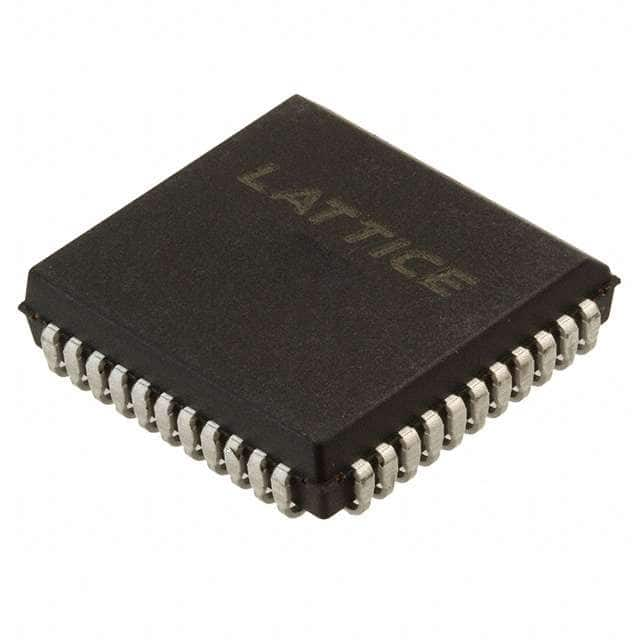Viz Specifikace pro podrobnosti o produktu.

ISPLSI 2032A-110LJ44
Product Overview
Category
ISPLSI 2032A-110LJ44 belongs to the category of programmable logic devices (PLDs).
Use
This product is commonly used in digital circuit design and implementation. It provides a flexible and customizable solution for various applications.
Characteristics
- Programmable: The ISPLSI 2032A-110LJ44 can be programmed to perform specific functions based on user requirements.
- High-density: This PLD offers a high number of logic elements, allowing for complex designs.
- Low power consumption: It operates efficiently with low power requirements.
- Fast operation: The device offers high-speed performance, enabling quick processing of digital signals.
Package
The ISPLSI 2032A-110LJ44 comes in a 44-pin plastic quad flat pack (PQFP) package.
Essence
The essence of this product lies in its ability to provide reconfigurable logic functionality, allowing designers to implement custom digital circuits without the need for dedicated hardware.
Packaging/Quantity
Each package contains one ISPLSI 2032A-110LJ44 device.
Specifications
- Logic Elements: 32 macrocells
- I/O Pins: 32
- Operating Voltage: 3.3V
- Maximum Frequency: 110 MHz
- Programming Technology: In-System Programmable (ISP)
- Configuration Memory: Non-volatile Flash memory
- Package Type: PQFP
- Package Dimensions: 10mm x 10mm
Detailed Pin Configuration
The ISPLSI 2032A-110LJ44 has a total of 44 pins. The pin configuration is as follows:
- VCCIO
- GND
- IO0
- IO1
- IO2
- IO3
- IO4
- IO5
- IO6
- IO7
- IO8
- IO9
- IO10
- IO11
- IO12
- IO13
- IO14
- IO15
- IO16
- IO17
- IO18
- IO19
- IO20
- IO21
- IO22
- IO23
- IO24
- IO25
- IO26
- IO27
- IO28
- IO29
- IO30
- IO31
- GND
- VCCIO
- TCK
- TMS
- TDI
- TDO
- GND
- VCC
- GND
- VCC
Functional Features
- In-System Programmable (ISP): The ISPLSI 2032A-110LJ44 can be programmed while in operation, eliminating the need for physical device replacement.
- Flexible I/O Configuration: The device offers configurable I/O pins, allowing designers to adapt to different interface requirements.
- JTAG Boundary Scan: It supports Joint Test Action Group (JTAG) boundary scan, enabling efficient testing and debugging of the circuit.
Advantages and Disadvantages
Advantages
- Flexibility: The ISPLSI 2032A-110LJ44 provides a flexible solution for digital circuit design, accommodating various applications.
- Cost-effective: By eliminating the need for dedicated hardware, this PLD reduces costs associated with custom circuit implementation.
- Reconfigurability: The ability to reprogram the device allows for iterative design improvements without hardware modifications.
Disadvantages
- Learning Curve: Utilizing programmable logic devices requires a learning curve for designers who are not familiar with the technology.
- Limited Resources: The ISPLSI 2032A-110LJ44 has a finite number of logic elements and I/O pins, which may restrict the complexity of designs.
Working Principles
The ISPLSI 2032A-110LJ44 operates based on the principles of reconfigurable logic. It consists of configurable logic blocks (CLBs) that can be programmed to perform specific functions. These CLBs are interconnected through programmable interconnect resources, allowing for the creation of complex digital circuits.
Detailed Application Field Plans
The ISPLSI 2032A-110LJ44 finds applications in various fields, including:
- Embedded Systems: It can be used to implement custom logic in microcontroller-based systems.
- Communication Systems: This PLD enables the design of specialized communication protocols and interfaces.
- Industrial Automation: It provides flexibility in implementing control logic for industrial automation systems.
- Consumer Electronics: The ISPLSI 2032A-110LJ44 can be utilized in designing custom digital circuits for
Seznam 10 běžných otázek a odpovědí souvisejících s aplikací ISPLSI 2032A-110LJ44 v technických řešeních
Sure! Here are 10 common questions and answers related to the application of ISPLSI 2032A-110LJ44 in technical solutions:
Question: What is the maximum number of usable I/O pins on the ISPLSI 2032A-110LJ44?
Answer: The ISPLSI 2032A-110LJ44 has a total of 32 I/O pins that can be used for input or output.Question: What is the operating voltage range for the ISPLSI 2032A-110LJ44?
Answer: The operating voltage range for this device is typically between 3.0V and 3.6V.Question: Can the ISPLSI 2032A-110LJ44 be programmed in-system?
Answer: Yes, this device supports in-system programming (ISP) which allows for easy reconfiguration without removing it from the system.Question: What is the maximum number of macrocells available in the ISPLSI 2032A-110LJ44?
Answer: This device has a total of 32 macrocells, which can be used for implementing various logic functions.Question: Does the ISPLSI 2032A-110LJ44 support JTAG boundary scan testing?
Answer: Yes, this device supports JTAG boundary scan testing, which enables efficient testing and debugging of the design.Question: What is the maximum frequency at which the ISPLSI 2032A-110LJ44 can operate?
Answer: The maximum operating frequency for this device is typically around 110 MHz.Question: Can the ISPLSI 2032A-110LJ44 be used in high-temperature environments?
Answer: Yes, this device is designed to operate in a wide temperature range, typically between -40°C and 85°C.Question: Does the ISPLSI 2032A-110LJ44 support internal pull-up or pull-down resistors?
Answer: Yes, this device has programmable pull-up and pull-down resistors that can be enabled for individual I/O pins.Question: What programming options are available for the ISPLSI 2032A-110LJ44?
Answer: This device can be programmed using various methods, including JTAG, SPI, or parallel programming modes.Question: Can the ISPLSI 2032A-110LJ44 be used in battery-powered applications?
Answer: Yes, this device is designed to be power-efficient and can be used in battery-powered applications with appropriate power management techniques.
Please note that these answers are general and may vary depending on specific application requirements and datasheet specifications.

